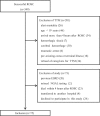Predictive performance of plasma neutrophil gelatinase-associated lipocalin for neurologic outcomes in out-of-hospital cardiac arrest patients treated with targeted temperature management: A prospective observational study
- PMID: 31441881
- PMCID: PMC6716698
- DOI: 10.1097/MD.0000000000016930
Predictive performance of plasma neutrophil gelatinase-associated lipocalin for neurologic outcomes in out-of-hospital cardiac arrest patients treated with targeted temperature management: A prospective observational study
Abstract
Few studies have demonstrated the prognostic potential of neutrophil gelatinase-associated lipocalin (NGAL) in post-cardiac arrest patients. This study evaluated the usefulness of plasma NGAL in predicting neurologic outcome and mortality in out-of-hospital cardiac arrest (OHCA) patients treated with targeted temperature management (TTM). A prospective observational study was conducted between October 2013 and April 2016 at a single tertiary hospital. We enrolled 75 patients treated with TTM and collected their demographic data, cardiopulmonary resuscitation-related information, data on plasma NGAL concentration, and prognostic test results. Plasma NGAL was measured at 4 hours after return of spontaneous circulation (ROSC). The primary endpoint was the neurologic outcome at discharge and the secondary outcome was 28-day mortality. Neurologic outcomes were analyzed using a stepwise multivariate logistic regression while 28-day mortality was analyzed using a stepwise Cox regression. The predictive performance of plasma NGAL for neurologic outcome was measured by the area under the receiver operating characteristic curve and the predictability of 28-day mortality was measured using Harrell C-index. We also compared the predictive performance of plasma NGAL to that of other traditional prognostic modalities for outcome variables. Thirty patients (40%) had good neurologic outcomes and 53 (70.7%) survived for more than 28 days. Plasma NGAL in patients with good neurologic outcomes was 122.7 ± 146.7 ng/ml, which was significantly lower than that in the poor neurologic outcome group (307.5 ± 269.6 ng/ml; P < .001). The probability of a poor neurologic outcome was more than 3.3-fold in the NGAL >124.3 ng/ml group (odds ratio, 3.321; 95% confidence interval [CI], 1.265-8.721]). Plasma NGAL in the survived group was significantly lower than that in the non-survived group (172.7 ± 191.6 vs 379.9 ± 297.8 ng/ml; P = .005). Plasma NGAL was significantly correlated with 28-day mortality (hazard ratio 1.003, 95% CI 1.001-1.004; P < .001). The predictive performance of plasma NGAL was not inferior to that of other prognostic modalities except electroencephalography. Plasma NGAL is valuable for predicting the neurologic outcome and 28-day mortality of patients with OHCA at an early stage after ROSC.This study was registered at ClinicalTrials.gov on November 19, 2013 (Identifier: NCT01987466).
Conflict of interest statement
The authors have no commercial associations or sources of support that might pose a conflict of interest.
Figures



References
-
- Wijdicks EF, Hijdra A, Young GB, et al. Practice parameter: prediction of outcome in comatose survivors after cardiopulmonary resuscitation (an evidence-based review): report of the Quality Standards Subcommittee of the American Academy of Neurology. Neurology 2006;67:203–10. - PubMed
-
- Zandbergen EG, Hijdra A, Koelman JH, et al. Prediction of poor outcome within the first 3 days of postanoxic coma. Neurology 2006;66:62–8. - PubMed
-
- Bouwes A, Binnekade JM, Kuiper MA, et al. Prognosis of coma after therapeutic hypothermia: a prospective cohort study. Ann Neurol 2012;71:206–12. - PubMed
-
- Rossetti AO, Rabinstein AA, Oddo M. Neurological prognostication of outcome in patients in coma after cardiac arrest. Lancet Neurol 2016;15:597–609. - PubMed
-
- Seder DB, Sunde K, Rubertsson S, et al. Neurologic outcomes and postresuscitation care of patients with myoclonus following cardiac arrest. Crit Care Med 2015;43:965–72. - PubMed
Publication types
MeSH terms
Substances
Associated data
LinkOut - more resources
Full Text Sources
Medical
Miscellaneous

